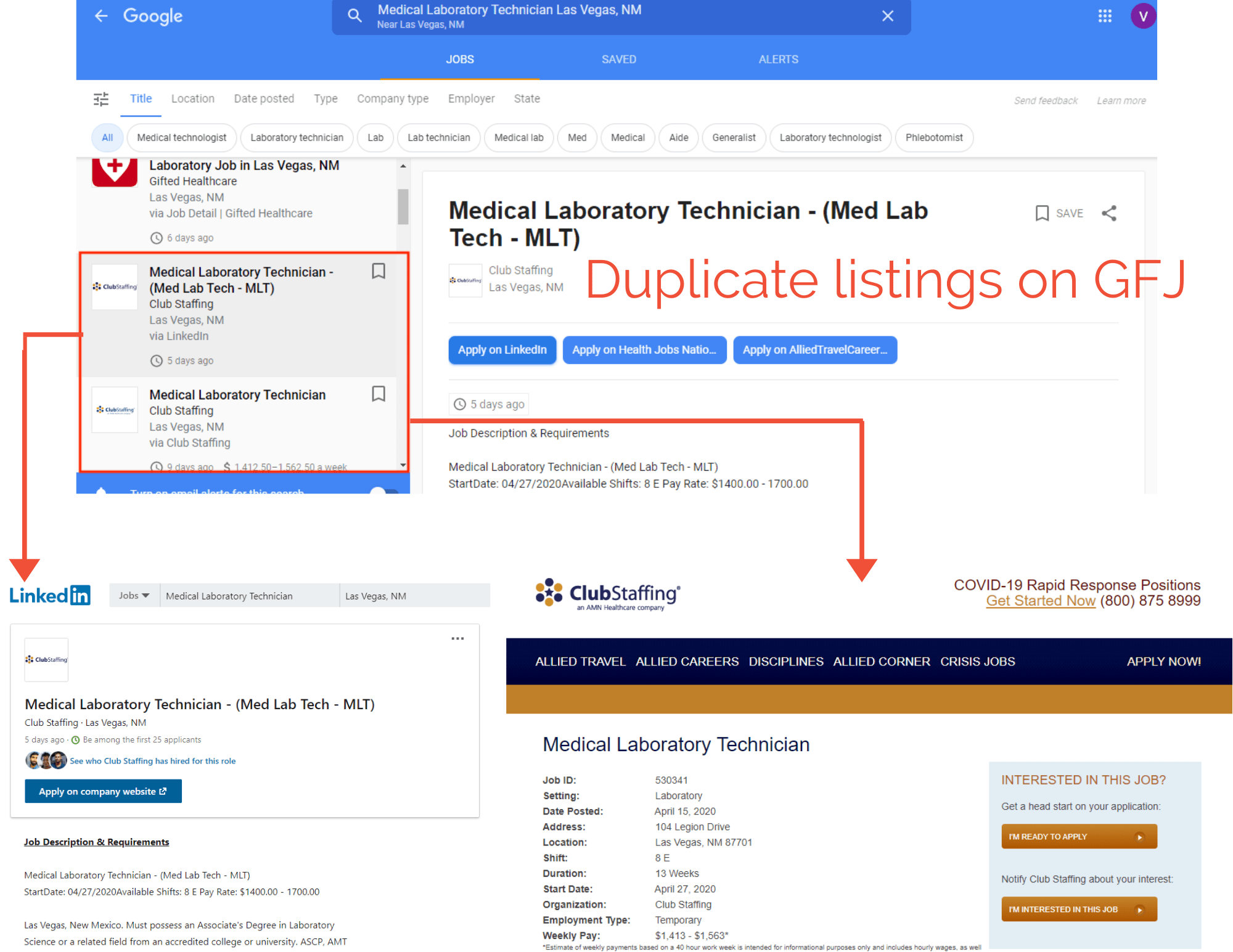
In 2017 Google launched Google for Jobs, the company’s job search platform that aimed to aggregate job postings from across the Internet and create a one-stop-shop for employers and job seekers alike. The vision was clear: applicants would be able to find work, easily and directly, right from the place they already search for virtually everything else: Google.
Google’s job platform was intended to house all jobs (optimized, streamlined, and organized), from anywhere: whether listed on job boards, Applicant Tracking Systems (ATS), Recruitment Marketing Platforms (RMPs), or even individual career sites.
Despite this being a massive challenge, it wasn’t insurmountable given Google’s history of creating world-class products.
However, a few years after launch, Google for Jobs is not an even playing field for all everyone posting jobs. This is, surprisingly, even the case for jobs that are posted through some of the biggest ATSs on the market; in fact, jobs from many of these platforms rarely even make it onto Google — let alone to the top of search results.
Several predominant practices, applied by job boards and other large organizations, have stifled the success of ATSs on Google for Jobs. These companies (which include major job boards and programmatic advertising platforms) are focused primarily on generating clicks and conversions, which has created a sub-optimal candidate experience and led employers to struggle to optimize jobs. While these are issues for the Google for Jobs experience itself, they signficantly inhibit the success of ATSs.
In this article, we take a look at these practices that are hurting ATS results on Google for Jobs and examine some emerging solutions that have the potential to right the ship.
Let’s get started!
While Google for Jobs has, in some ways, streamlined the candidate application process by creating fewer steps to apply (one of the reasons for higher applicant conversion rates on Google), there many instances where the experience can be tedious for job seekers.
For example, any given Google job posting can have anywhere from 2 to 6 locations to which a candidate can apply.
Aside from creating confusion (where is the best place to apply?!), it also takes time that can negatively impact applicant conversion rates.
Additionally, applicants are concerned that they aren’t applying to the right places. Because time is of the essence and the fact that it takes as many as 80 applications (if not more) to land a job, job seekers don’t won’t risk wasting time applying to jobs on websites where their applications may never even be seen.

In fact, candidates must complete an average of 2.5 steps before even reaching an employer’s website in the first place. This elongated job application process often results in candidates abandoning their applications entirely. In fact, over 60 percent of online applications are abandoned before candidates even reach an employer’s website.
Unfortunately, job boards and programmatic job advertising platforms often don’t care.
Why?
Simple: they still get paid (by the click).
This means that the primary objective for many of the active job posts on Google for Jobs is simply to generate the clicks and resumes that, for these companies, translate directly to higher revenues.

Because these third-party sites get their jobs optimized, ranked, seen, and clicked on by job seekers on Google, they win (at least in the short term) regardless of the quality of the candidate experience.
This poor candidate experience impacts everyone else – applicants are frustrated with the experience, and the employers who are looking to fill open jobs are seeing limited results from a platform that holds so much promise for talent acquisition and recruitment leaders.
Another reason that the jobs coming from ATSs are unsuccessful on Google for Jobs is the proliferation of spam content.
In an attempt to get more eyes on their job posts, many third party job boards create multiple instances (with small tweaks) of the exact same jobs.
This once again comes what counts as “success” for them: the more clicks they get on their job posts, the more money they make.
The spam approach creates an onslaught of duplicate listings that clutters the Google for Jobs ecosystem. So, not only is the user experience impacted once a candidate decides to click on a job, but finding the right jobs in the first place becomes that much harder.
Additionally, job feeds are further cluttered by expired and inactive job listings that these job boards fail to remove from search results (note: the Google bot has gotten better and better at flagging such posts and penalizing those responsible).

All these culminate in making it increasingly harder for “legitimate” jobs to be seen on Google for Jobs. Job seekers often must sift through hundreds of irrelevant listings, un-economically spending time and energy that further contributes to those high application abandonment rates and increased frustration with the Google for Job’s platform.
Fraudulent and fake job posts are another major contributor to ATSs struggling to make the most of Google for Jobs.
These types of job posts are not unlike spam posts – both clutter the feeds of job seekers with the intent of capturing their clicks.
Fake listings, however, don’t exist with the hope of sending candidates to legitimate job posts. Rather, they (eventually) direct users to a home or service page.
The intent with these posts is actually to try and get job seekers to purchase something (a learning platform, for example). Unlike spam posts, fraudulent job postings append information in a job post to get job seekers to think they are clicking on a different job than they otherwise would.
For example, a job title might actually be posted a step or two up the corporate ladder. This misleads candidates into clicking on them… only to later find out that they’ve been duped.
While adjusting job listings to include certain keywords and optimizations is fine (and even encouraged in order to maximize visibility on GFJ), this takes things a step too far.
Fraudulent posts might advertise something that sounds great — a part-time, work-from-home teaching gig, for example. However, if you were to go further down the click journey, you might often end up on a website selling that’s actually selling you tutoring services or a class.
After learning more about why ATSs are struggling with Google for Jobs, you may be wondering a few things:
Unfortunately, there is a high barrier to entry for optimized job posts on Google for Jobs.
In order for job posts to make it onto the platform, they must be optimized to fit Google’s complex schema requirements.
Many ATSs do not implement Google’s desired structured data at all. And those that do have limited success aligning the content of job posts with all of Google for Jobs’ required fields.
The result is what we’ve illustrated above: a platform that’s supposed to cull the best and most relevant jobs but is instead being manipulated for profit.
Emerging AI and automation-based recruitment technologies present an opportunity for ATSs to even the Google for Jobs playing field, getting their most relevant jobs in front of the most relevant candidates.
With dozens of key ranking signals optimized for these organizations, the technology is uniquely designed to optimize, structure, and post all jobs in a way that quickly accelerates qualified candidate flow.
The algorithms are even able to scan and implement targeted keywords, SEO optimizations, meta tags, market and industry signals, location, and other information so that jobs are not only posted but ranked highly in Google search results.
One of the best parts? This is all accomplished in a matter of hours, not days or weeks.
The benefits for ATSs are significant:
That’s right – with automation, ATSs can make the most of the place where the majority of job seekers start their searches: Google.
Getting Google for Jobs right can quickly become a full-time job. Let AI and automation check all the boxes for you.